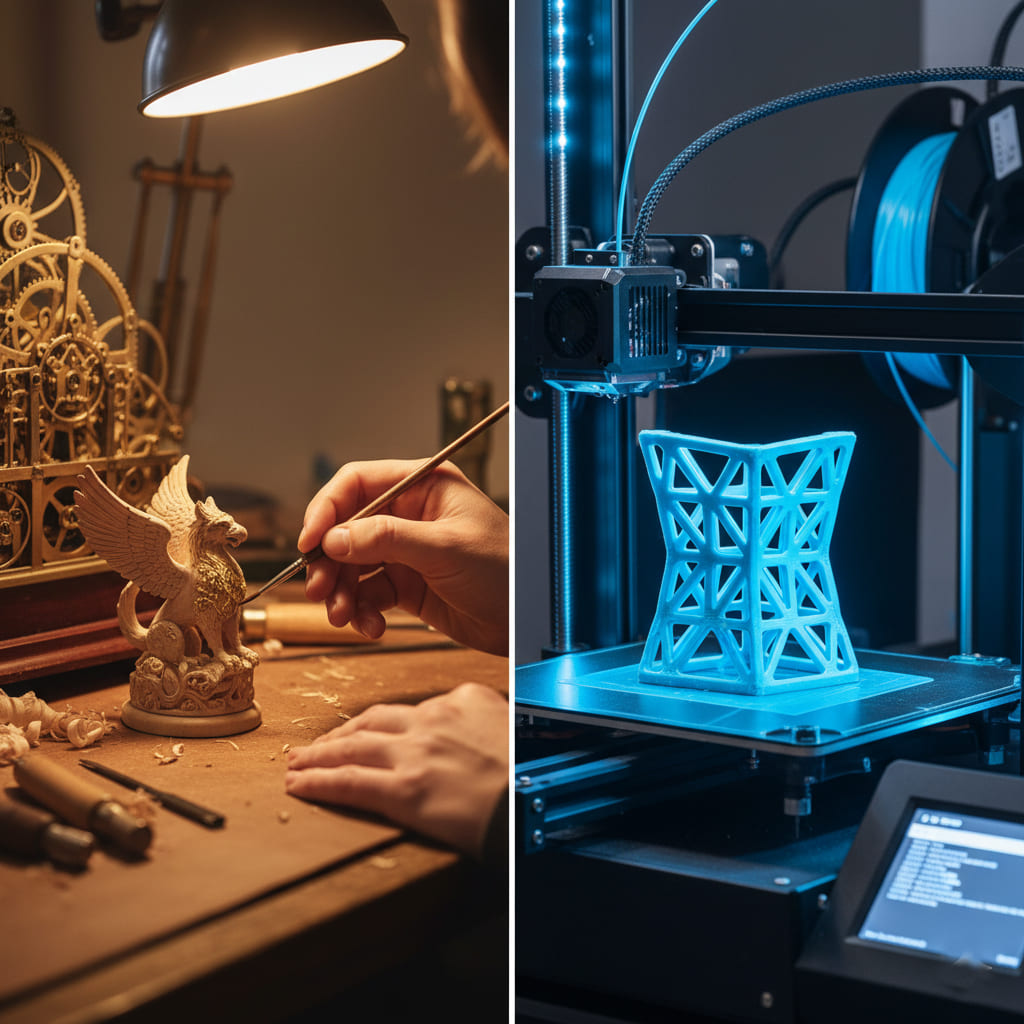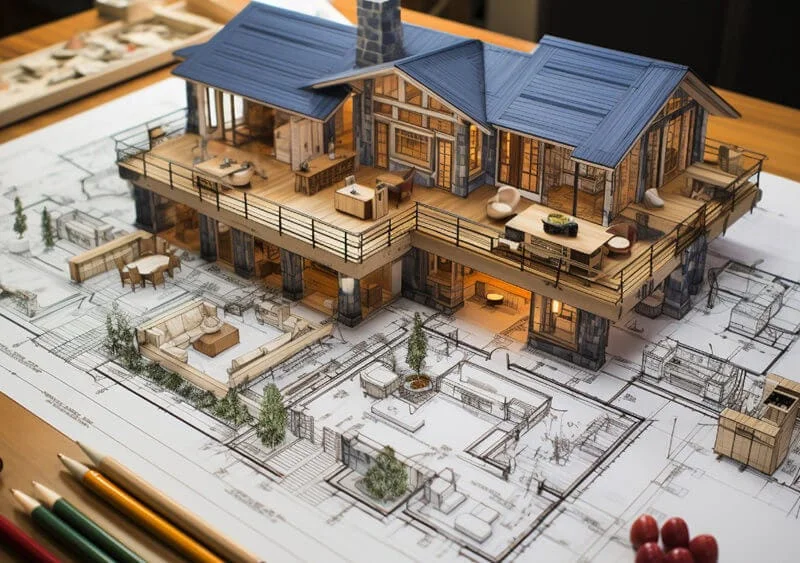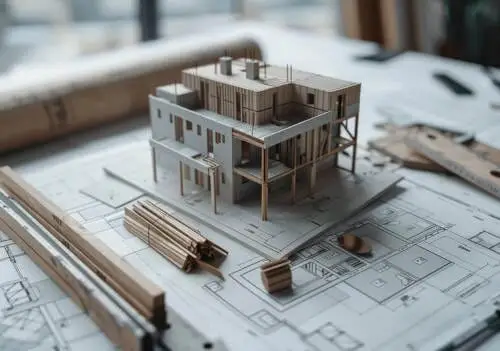İçindekiler

Zanaatkarın Kalıcı Mirası: Geleneksel El İşçiliğinin Gücü
Dijital devrimi keşfetmeden önce, Öncelikle tüm harika modellerin üzerine inşa edildiği temele saygı göstermeliyiz: insan elinin becerisi. Geleneksel el işçiliği modası geçmiş bir yöntem değildir; bu önemli bir koleksiyon, sanatı sağlayan yüksek dokunuş becerileri, nüans, ve makinelerin tek başına kopyalayamayacağı ruh. Kusursuz bir kopyayı ilgi çekici bir sanat eserine dönüştüren, kritik insan unsurudur..
Çıkarıcı Heykel Sanatı: Oyma ve Şekillendirme
En temel düzeyde, geleneksel model yapımı bir heykel sanatıdır. Bu, bir zanaatkarın el aletlerini (dosyaları) kullanma sürecidir, keskiler, değişen taneciklerdeki zımpara kağıtları - katı bir ahşap veya köpük bloğunu organik veya karmaşık bir forma dönüştürmek için. Bu yavaş, Yıllar süren gelişmiş hislere ve malzemenin sezgisel anlayışına dayanan metodik süreç.
- Güçlü yönler: Bu yaklaşım benzersiz yaratma konusunda eşsizdir, tekrarlanmayan formlar, ince eğrilikler, ve gerçekten ısmarlama bir sonuca ulaşmak “hissetmek.” Erken aşama için mükemmeldir kavramsal modeller sanatsal ifadenin ve biçimin araştırılmasının en önemli olduğu yer.
- Sınırlamalar: Süreç doğası gereği yavaş ve emek yoğundur. Bir şekli mükemmel şekilde kopyalamak da zordur, bir gökdelenin pencere dikmeleri gibi yüzlerce aynı bileşenin oluşturulmasına daha az uygun hale geliyor.
Yüzeyin Ruhu: Ustaca Boyama ve Bitirme
Zanaatkar dokunuşunun vazgeçilmez kaldığı belki de en kritik alandır burası. Bir makine bir kat boya uygulayabilir, ancak usta bir son işlemcinin incelikli sanatını taklit edemez. Bu sadece renkten çok daha fazlasıdır; inanılırlık yaratmakla ilgilidir.
Usta Ressam Ne Yapar?:
- Titiz Hazırlık: Süreç kapsamlı yüzey hazırlığıyla başlar, ince zımparalama dahil, birden fazla astar katmanı uygulamak, ve kusursuz bir tuval oluşturmak için katlar arasında ıslak zımparalama.
- İnce Ayrışma ve Tekstüre: Gelişmiş airbrushing ve ince kıllı fırça tekniklerini kullanma, bir zanaatkar, bir modeli inandırıcı kılan ince kusurları yaratabilir. Bu bir tuğla cephedeki hafif renk değişimi olabilir, taş duvardaki hafif eskime, veya dökme betonun yumuşak dokusu.
- Kusursuz Yüzeyler: Bir uzman mükemmele ulaşabilir, otomotiv sınıfı parlak kaplama veya tamamen tekdüze, yansıtmayan mat kaplama — dikkatli gözlerin hemen fark ettiği bir kalite düzeyi.
İnsan gözü hala rengi yargılamak için en iyi araçtır, doku, ve gerçekçilik. Bir zanaatkar, bir makinenin yapamayacağı düzeyde bir yüzey nüansı yaratabilir. Farklı malzemelerin bu yüzeyleri nasıl aldığına dair tam bir araştırma için, bizimkine bakın Model Malzemelerine İlişkin Kapsamlı Kılavuz.
Nihai Perde: Hassas Montaj ve Detaylandırma
Final, Model yapımının kritik aşaması montajdır, yüzlerce veya binlerce ayrı bileşenin bir araya getirilerek tutarlı bir bütün oluşturduğu yer. Bu, büyük sabır gerektiren, yüksek riskli bir bulmacadır, sabit bir el, ve uyum için keskin bir göz.
“Bir makine binlerce mükemmel parçayı kesebilir, ama onları ruhla buluşturmak için sanatçı gerekir.”
Usta bir montajcının becerisi mükemmelliği sağlamaktır., mikroskobik hizalama, temiz yaratmak, görünmez dikişler, ve son çevre elemanlarını hassas bir şekilde yerleştirme (minik ağaçlar, arabalar, Ve insanlar) sahneye hayat veren. İyi yapabilirler, Mükemmel uyum sağlamak için anında ayarlamalar, programlanması imkansız olan duyarlı bir beceri. Finalde nefes alan şey budur “hayat” modelin içine.

Dijital Devrim: Modern Zanaatın Gücü
Modern zanaat, mükemmel bir dijital dosyayı hatasız bir şekilde mükemmel bir fiziksel nesneye dönüştürme işlemidir., tekrarlanabilir doğruluk. Bu teknolojik sıçrama, bilgisayar destekli tasarımla desteklenmektedir (CAD) ve dijital üretim, insan elinin birçok fiziksel sınırlamasını ortadan kaldırdı. Karmaşıklığın yeni sınırlarını açtı, hız, Model yapımında hassasiyet ve hassasiyet, izin veren mimarlar’ gerçekleştirilecek en iddialı vizyonlar.
3D baskı (Katkı maddesi üretimi): İmkansızı İnşa Etmek
Modern model yapımında en dönüştürücü teknoloji şüphesiz 3D baskıdır.. Temel kavram şudur: “katkı maddesi üretimi”—hiçbir şeyden mikroskobik katmanla bir nesne katmanı oluşturmak. Bu, geleneksel yöntemlerle kesilmesi veya birleştirilmesi imkansız olan şekillerin oluşturulmasına olanak tanır.
| Mimarlıkta Temel 3D Baskı Teknolojileri | |||
|---|---|---|---|
| Teknoloji | Nasıl Çalışır? | En İyisi | Anahtar Gücü |
| Stereolitografi (HDS) | UV lazer, sıvı fotopolimer reçineyi katman katman iyileştirir. | Karmaşık cepheler, dekoratif ekranlar, pürüzsüz yüzeyli sunum parçaları. | Olağanüstü Detay & Pürüzsüzlük. Enjeksiyon kalıplamaya benzer kalitede parçalar üretir. |
| Erimiş Biriktirme Modellemesi (FDM) | Isıtılmış bir nozül, termoplastik bir filamenti dışarı çıkarır (PLA veya ABS gibi) katman katman. | Erken aşama kitleselleştirme modelleri, iç yapısal bileşenler, daha büyük, daha az detaylı parçalar. | Hız & Düşük Maliyet. Hızlı prototipleme ve güçlü iş gücü, fonksiyonel parçalar. |
| Seçici Lazer Sinterleme (SLS) | Yüksek güçlü bir lazer, toz halindeki naylonu veya diğer polimerleri katman katman birleştirir. | Karmaşık geometriler, birbirine kenetlenen parçalar, dayanıklı fonksiyonel prototipler. | Tasarım Özgürlüğü. Destek yapısı gerektirmez, son derece karmaşık şekillere izin verir. |
Bu teknolojinin etkisi o kadar derin ki, konuyu derinlemesine ele aldık.. Daha fazlasını öğrenmek için, Okumak Mimarlıkta 3D Baskının Devrimi.
Lazer kesimi (2D Çıkarıcı): Temiz Kenarların Kralı
Lazer kesim, modern atölyenin bir diğer temel taşıdır. Süreç yüksek güçlü bir süreç içeriyor, Akrilik gibi levha malzemelerden 2 boyutlu şekilleri hassas bir şekilde kesen bilgisayar destekli lazer ışını, odun, ve karton. Bunu inanılmaz bir hız ve doğrulukla yapar, temiz bırakmak, Çok az manuel sonlandırma gerektiren veya hiç gerektirmeyen, genellikle cilalanmış kenar.
- Güçlü yönler: Düz bileşenler oluştururken hız ve hassasiyet açısından eşsizdir. Buna mükemmel derecede hassas zemin plakaları da dahildir, ayak izi oluşturma, site planı düzenleri, ve tekrarlanan cephe panelleri. Lazer kesici, bir gökdelen modelindeki binlerce pencere açıklığından her birinin tamamen aynı olmasını garanti eder.
- Sınırlamalar: 2 boyutlu bir süreç olarak, sadece profil kesebilir ve kendi başına üç boyutlu formlar oluşturamaz. Sihir, bu mükemmel kesilmiş 2 boyutlu parçalar 3 boyutlu bir nesneye birleştirildiğinde ortaya çıkar.
CNC Frezeleme (3D Çıkarıcı): Kütle ve Topografyanın Efendisi
CNC (Bilgisayar Sayısal Kontrolü) frezeleme, oymacılığın ileri teknoloji evrimidir. Bilgisayar kontrollü bir kesici takımın kullanıldığı çıkarmalı bir işlemdir. (yüksek hızlı bir matkap ucu gibi) katı bir malzeme bloğundan 3 boyutlu bir şekil oluşturur, yüksek yoğunluklu köpük gibi, odun, hatta alüminyum.
- Güçlü yönler: Büyük oluşturmak için kesinlikle en iyi yöntemdir., Dijital araştırma verilerine dayanan mükemmel kontur doğruluğuna sahip sağlam topografik model tabanları. Aynı zamanda hızlı bir şekilde basit üretimler yapmak için de mükemmeldir., kentsel planlama çalışmaları veya rüzgar tüneli testleri için katı bina kütleleme modelleri.
- Sınırlamalar: İç detayları olan içi boş veya son derece karmaşık parçalar oluşturmak için 3D baskıdan daha az verimlidir..
Eylemdeki Sinerji: Nasıl “vs.” olur “VE”
Bu modernliğin özüdür., üst düzey model yapımı felsefesi. Birinci sınıf bir model, bir tekniğin diğerine üstünlüğünü gösteren bir vitrin değildir; her ikisinin de kusursuz ve akıllı bir entegrasyonudur. Gerçek uzmanlık, iş akışındaki her özel görev için hangi aracın (el veya makine) doğru olduğunu bilmekte yatmaktadır.. Bu, her iki yöntemin tek başına başarabileceğinden daha üstün bir nihai ürün yaratmak için her birinin güçlü yanlarından yararlanmakla ilgilidir..

Birinci Sınıf Bir Bileşenin Anatomisi: Yüksek Detaylı Bir Cephe
Bu hibrit süreçten geçmek için pratik bir örnek kullanalım. Bir single oluşturduğunuzu hayal edin, lüks bir kule için karmaşık cephe paneli:
- Dijital Vakıf: Süreç, mimarın mükemmel CAD dosyasıyla başlar. Bu, boyutsal doğruluğu garanti eden gerçeğin değişmez kaynağıdır.
- Yapısal Arka Panel (Lazer Kesici): Cephenin sağlam arka plakası, sağlamlık sağlayan, bir akrilik levhadan hassas bir şekilde lazerle kesilmiştir. Bu, mükemmel şekilde kare olmasını ve tüm montaj noktalarının tam olarak doğru yerde olmasını sağlar.
- Karmaşık Ekran (3D Yazıcı): Bir kompleks, Yapının önüne oturan parametrik dekoratif ekran daha sonra yüksek çözünürlüklü SLA 3D yazıcı kullanılarak üretilir. Bu karmaşık olanı yakalar, elle yapılması imkansız olan organik detay.
- Kusursuz Sonlandırma (İşi): Ham 3D baskılı parça, kesin iken, mikroskobik katman çizgileri olabilir. Artık cam pürüzsüzlüğünde bir yüzey elde etmek için titizlikle ıslak zımparalayan usta bir zanaatkâra teslim edilmiştir.. Daha sonra çok katmanlı bir boya uygulayan bir ressama gider., Özel bir püskürtme kabininde otomotiv sınıfı boya kaplaması.
- Nihai Meclis (İşi): Yetenekli bir montajcı, mikroskop ve özel aparatlar kullanarak, Mükemmel şekilde boyanmış ekranı mükemmel kesilmiş arka panele mikroskobik hassasiyetle dikkatlice yapıştırır, temizliğin sağlanması, görünmez dikiş.
Bu örnekte, makine hızı ve hassasiyeti sağladı; el ruhu ve kusursuz bitişi sağladı. Bu sinerji özellikle büyük şirketlerde önemlidir., incelediklerimiz gibi karmaşık projeler Master Plan Modeli Sanatı.
| Hibrit İş Akışı: Teknoloji VE El İşçiliği | |||
|---|---|---|---|
| Görev | Teknolojinin Rolü (Kesinlik & Hız) | El İşçiliğinin Rolü (Nüans & Sanat) | Üstün Sonuç |
| Topografik Temel Oluşturma | 5 eksenli bir CNC freze, yüksek yoğunluklu köpükten konturları dijital verilerden mükemmel doğrulukla keser. | Bir zanaatkar ince dokular uygular, renkler, ve peyzaj düzenlemesinin ilk katmanları elle. | Mükemmel derecede doğru ve güzel gerçekçi bir manzara temeli. |
| Karmaşık Bir Cephe İmalatı | Bir SLA 3D yazıcı karmaşık olanı üretir, geometrik olarak karmaşık dış ekran. | Usta bir ressam çok aşamalı bir teknik uygular, ham parçaya incelikli boya kaplaması. | Hem geometrik olarak mükemmel hem de estetik açıdan ikna edici bir cephe. |
| Üretmek 1,000 Pencere Çerçeveleri | Bir lazer kesici, akrilik levhadan her bir kareyi mükemmel bir şekilde keser, çok kısa bir sürede tekrarlanabilir hassasiyet. | Bir zanaatkar her çerçeveyi titizlikle kurar, mükemmel hizalama ve temiz bir uyum sağlamak. | Kusursuz ve temiz bir bina dış cephesi, çok daha kısa bir zaman diliminde tamamlandı. |
| Gerçekçi Peyzaj Oluşturma | Lazer kesiciler ağaçlar için armatür üretebilir; 3D yazıcılar benzersiz sokak mobilyaları yaratabilir. | Bir sanatçı her ağacın yapraklarını elle işliyor, çeşitli zemin örtüsünü uygular, ve sahneyi hazırlıyor. Bunu şu şekilde araştırıyoruz: Gerçekçi Peyzajın Sırları. | Canlı bir, inandırıcı minyatür dünya. |
Nihai Ürün Üzerindeki Etki: Bu Füzyonun Sizin İçin Anlamı Ne?
Bu hibrit süreci anlamak ilginç, ama müşteri olarak sizin için aslında ne anlama geliyor?? Faydaları sadece felsefi değil; bunlar projenizin başarısını doğrudan etkileyen somut iyileştirmelerdir.
Eşsiz Kalite ve Detay
Tekniklerin birleşimi, her iki dünyanın da gerçekten en iyisi olan nihai bir ürünün ortaya çıkmasına olanak tanır. Tamamen manuel tekniklerle hayal edilemeyecek olan, akıl almaz geometrik karmaşıklığa ve mükemmel boyutsal doğruluğa sahip olursunuz.. Aynı zamanda, sen duygusal olanı al, incelikli, ve tamamen makine yapımı nesnelerde bulunmayan hiper gerçekçi yüzeyler. Basitçe doğru olan bir model ile gerçekten büyüleyici olan bir model arasındaki fark budur. Bunu başarabilme yeteneği, birçok firmanın küresel üretim merkezlerine yönelmesinin temel nedenidir, ayrıntılarıyla anlattığımız bir strateji Çin avantajı.
Hızlandırılmış Zaman Çizelgeleri ve Artan Güvenilirlik
Hız büyük bir avantajdır. En çok tekrarlanan ve zaman alan görevleri otomatikleştirerek (kesmek gibi 1,000 aynı pencere çerçeveleri), üretim zaman çizelgesi önemli ölçüde sıkıştırıldı. Bu verimlilik, usta zanaatkarların değerli zamanlarını, benzersiz becerilerini gerektiren yüksek etkili görevlere odaklamalarına olanak sağlar., resim yapmak gibi, bitirme, ve son montaj. Bu paralel iş akışı, projenizin daha hızlı ve daha öngörülebilir şekilde tamamlanması anlamına gelir.
Gelişmiş Değer Teklifi
Bu operasyonel verimlilik doğrudan yatırımınız için daha iyi bir değer anlamına gelir. Bu hibrit yaklaşıma hakim olan üst düzey bir firma, daha yüksek düzeyde ayrıntıya sahip bir model sunabilir, daha fazla karmaşıklık, ve daha gelişmiş özellikler (entegre gibi aydınlatma sistemleri) yalnızca daha basit bir bütçeyi kapsayabilecek bir bütçe için, eski modellere güvenen bir rakibin daha az etkileyici modeli, daha az etkili yöntemler. Bu, modern fiyatlandırma yapısının temel bir parçasıdır, bunu açıklıyoruz Ambalaj 5 Mimari model fiyatlandırmasının temel faktörleri.

Satın Alma Rehberi: Gerçek Hibrit Atölye Nasıl Tanımlanır?
Artık ideal süreci anladığınıza göre, potansiyel ortakları etkili bir şekilde inceleme yetkisine sahipsiniz. Bu yüzden, Bir firmanın bu sinerjiye gerçekten hakim olup olmadığını veya teknolojiye sadece sözde bağlılık mı gösterdiğini nasıl anlarsınız?? İşte aramanız gerekenler.
Portföyün Uzman Gözüyle Analizi
sergileyen bir portföy arayın. denge güçlü yönlerin. İnanılmaz geometrik karmaşıklığa ve karmaşık ayrıntılara sahip projeler görmelisiniz (gelişmiş dijital üretimin bir işareti). Ama aynı zamanda güzelliğin kanıtlarını da görmelisiniz., nüanslı yüzeyler, gerçekçi peyzaj, ve kusursuz montaj (yetenekli zanaatkarların bir işareti). Yalnızca tek bir gücü gösteren bir portföye karşı dikkatli olun; örneğin, geometrik olarak ilginç ancak kötü boyanmış modeller, veya iyi boyanmış ancak karmaşıklıktan yoksun basit modeller.
Potansiyel Bir Ortağa Sorulacak Temel Sorular
Potansiyel model yapımcılarıyla röportaj yaparken, Doğru soruları sormak onların gerçek felsefesini ve yeteneklerini ortaya çıkarabilir. İşte başlamanıza yardımcı olacak birkaç tane:
- “Tasarımımdan bu karmaşık cepheyi oluşturmak için kullanacağınız özel süreci bana anlatabilir misiniz?? Hangi parçalar makine yapımı, hangi parçalar elle bitirilecek??”
- “Üretim sürecinizin (özellikle 3D baskı ve lazer kesim) yüzde kaçı şirket içinde yapılıyor, yoksa dış kaynaklı mı??”
- “bana yakından gösterebilir misin, Son modellerinizin boyalarının rötuşlanmamış fotoğrafları?”
Doğru ortağı seçmenizi sağlayacak inceleme sorularının tam listesi için, rehberimiz 10 Bir model yapımcısı işe almadan önce sorulacak kritik sorular herhangi bir geliştirici veya mimar için önemli bir kaynaktır.
| Hibrit Atölye için İnceleme Kontrol Listesi | ||
|---|---|---|
| Değerlendirilecek Alan | Yeşil Bayrak (Gerçek Sinerjiyi Gösterir) | Kırmızı Bayrak (Süreç Dengesizliğini Gösterir) |
| Portföy | Yüksek teknoloji karmaşıklığı VE yüksek dokunuş arasındaki dengeyi gösterir, sanatsal bitirme. | Modeller ya geometrik olarak basittir ya da kötü gösterir, rafine edilmemiş yüzey kaplamaları. |
| Teknoloji | Şirket içi makinelerini gururla listeliyorlar ve her birinin güçlü yönleri hakkında konuşabiliyorlar. | Teknolojileri konusunda belirsizler ya da imalatların çoğunu dış kaynaklardan sağladıklarını kabul ediyorlar. |
| Takım Becerileri | Ekipleri hakkında uzmanlaşmış roller açısından konuşuyorlar: “usta ressamlar,” “elektronik uzmanları,” vesaire. | Takımlarına genel diyorlar “model yapımcıları” |
| Süreç Açıklaması | Özel projeniz için tekniklerin bir kombinasyonunu nasıl ve neden kullanacaklarını açıkça açıklayabilirler.. | Her şey için tek bir tekniği zorluyorlar veya iş akışlarını net bir şekilde açıklayamıyorlar. |
Çözüm: Ruh Sinerji İçinde
Eski tartışma “El vs. Makine” yaratıcı alanlarda bitti. Zafer her iki tarafa da ait değil; onların sendikasına ait. En değerli, Güzel, Günümüz dünyasındaki etkili ve etkili mimari modeller kusursuz bir, Dijital üretimin şaşmaz hassasiyeti ile usta zanaatkarın yeri doldurulamaz ruhu arasındaki akıllı ortaklık.
Bir model yapım ortağı seçerken, sadece bir tedarikçi seçmiyorsunuz; bir felsefe seçiyorsun. Bu sinerjiye hakim bir firmayı seçerek, mimari vizyonunuzun hem mükemmel hem de mükemmel bir şekilde hayata geçirilmesini sağlıyorsunuz, veriye dayalı doğruluk ve derin, insan odaklı sanat. Makinede ruhu olan bir model seçiyorsunuz.
Her İki Dünyanın En İyisini Deneyimlemeye Hazır?
En son teknoloji ile eskimeyen işçiliğin benzersiz birleşiminin, projenizi benzersiz kaliteyle nasıl hayata geçirebileceğini görmeye hazırsanız, uzman ekibimizle iletişime geçin. Hibrit sürecimizi tartışmaktan ve bir sonraki projeniz için ücretsiz danışmanlık hizmeti vermekten mutluluk duyarız.







